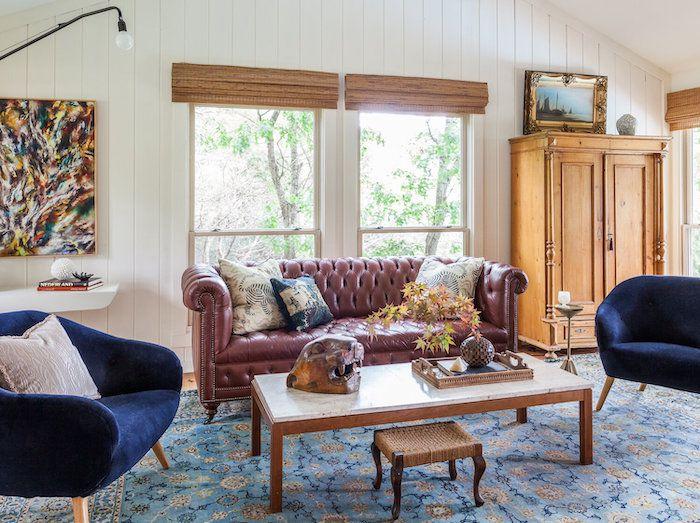Vintage shops and thrift stores can be treasure troves for all odds and ends to fill any space of the house—especially because vintage decor is having a major moment right now. But as sustainable and fun as antiquing can be, it does come with some drawbacks. According to design experts, if you're not careful, you could end up with items that are simply just old and not worth much.
To avoid losing money on something you'll want to donate or toss soon, designers and antique experts are sharing how to tell if a piece has vintage charm or is truly just tacky. Learn their best antiquing tips so you can score vintage decor without regret.
Why Is Vintage Decor So Popular Right Now?
Whether it's an antique mirror, ornate storage chest, or an idyllic oil painting, there's something special about decorating with secondhand finds. Is it their rich history, the character they bring, or just the thrill of scoring a great deal? Experts say it's all of the above.
"In fashion, the reason something is labeled a 'classic' is because it never goes out of style, like a white dress shirt or a well-tailored blazer—the same is true for interiors," designer Lucia Deen says.
"True antiques—100 years old or more—can help add a feeling of history and permanence to an interior space, but the wrong piece will make the space feel awkward and uncomfortable," Deen explains.
Ken Murphy of OfferUp explains there's also a steadfast community of people looking for items with "great bones," that they can upcycle into fresh decor. "Many shoppers specifically look for items with solid construction, quality materials, and unique details—knowing they can refinish, repaint, or reupholster to match their style," he says.
How to Incorporate Vintage Decor That Won't Look Tacky
Deen and Murphy agree that achieving the right look is all about cultivating balance. Go ahead and mix vintage and modern pieces to design spaces that feel curated, but swing too far in either direction, and you may end up with a space that feels either too new, overly nostalgic, or overly themed.
"If [antiques are used] correctly, these pieces will add character, texture, history and a little unexpected interest to a space," Deen says. For example, hanging a contemporary abstract painting above a carved French chest appointed with an art deco lamp sets the stage for a well balanced space, she explains. "What makes a home interesting is that unexpected mix, the eclectic mix of different styles and time periods," she says.
Murphy suggests using your vintage finds as statement pieces—like a mid-century coffee table in a contemporary living room—versus buying every single item secondhand. Or, seek out small accents like antique mirrors or retro lamps to add character and complement your existing modern pieces.
What to Look for When Shopping Secondhand
1. Look for Construction Clues
First, always study the time period of when the piece was made, suggests Deen. Start by asking these important questions: "Do the proportions and scale feel right? Are there any marks or labels on the piece to help determine its provenance? Look for clues from the construction such as the joinery and the type of wood or material used," Deen says.
2. Age Doesn't Always Guarantee Quality
Don't assume that all secondhand items are valuable or well-made just because they’re older. "In reality, quality varies widely," Murphy says. "What sets true vintage apart is craftsmanship, material quality, and design that stands the test of time."
To safeguard yourself from purchasing low-quality vintage items—or worse, counterfeit pieces—don't focus on the age alone. Instead, "always look for authenticity signals like recognizable brands, maker’s marks, and durable materials such as solid wood or hand-stitched textiles," Murphy says. Another great way to assess the value of your piece is simply by chatting directly with the seller, whether you shop online or in person. Never hesitate to ask questions about the item’s history, materials, and any distinctive features, Murphy suggests.
3. Seek Quality Craftsmanship
A great secondhand find comes down to well-crafted, long-lasting pieces. But, there's more to scoring a great find, price and value wise—you must read beyond the listing. "It's essential to do a little research," Murphy says. "Check listing details, compare similar items, ask the seller about the item’s history, and really examine your piece to confirm its condition and original manufacturing details."
Murphy suggests looking for solid wood, high-end construction techniques, genuine leather, hand-stitched textiles, and metal hardware, which are all signs of quality craftsmanship. "With some due diligence, secondhand shopping is one of the best ways to uncover unique, high-quality vintage finds that can last for generations," he says.
4. Know When an Item Is Past its Prime
"Look for items that have aged gracefully," Murphy says. "A vintage item with patina or minor wear can add character—and even value—but excessive damage or poor construction may signal that it won’t hold up over time."
Deen agrees. "Do not buy something in terrible condition just because it’s an antique," she says. "The condition and the appropriateness of the piece to your overall design goals is most important."
5. Check Reviews
Whether it’s your local antique market or an online platform, turn to community reviews, blogs, or expert insights for guidance. For example, interact with the seller when shopping on a secondhand platform or research your market's and seller's reputation if you're shopping in person.



